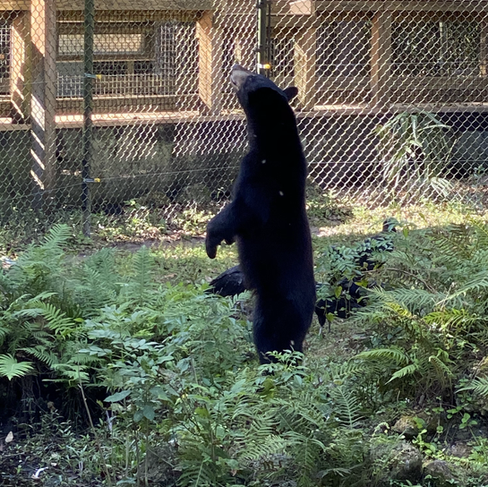Ellie Schiller Homosassa Springs Wildlife State Park
- Erika Gilsdorf
- May 10, 2021
- 4 min read
Updated: May 17, 2021
Homosassa, Florida
Thank you Caroline Martinez for all this great info and the wonderful photos you've shared with us below! I loved my time at the park!
Enjoy!
Ellie Schiller Homosassa Springs Wildlife State Park (formerly called other names) has been a popular attraction since the early 1900s when a train ran along Fishbowl Drive and travelers would stop to observe the fish in the spring. In the 1940s, a large tower was built to better view the spring and the wildlife around it.
During 1950s and 1960s the park was a private entertainment attraction and housed animal actors, including lions, bears, and Lu the hippo! In 1963 the park installed an underwater observatory so visitors could see the fish and manatees below the water.

It wasn't until January of 1989 that Homosassa Springs Park officially became Homosassa Springs Wildlife State Park then later its current name, Ellie Schiller Homosassa Springs Wildlife State Park.
A look at Lu
When the park service took over, the mission changed from an exotic animal attraction park to a rehabilitation sanctuary for Florida native species. The exotic animals were transferred to other facilities, but a petition was filed to keep Lu in Florida.
Governor Lawton Chiles granted him honorary citizenship, making Lu the only "Florida hippo" to date, as well as the oldest hippo in the Americas.
Inside the alligator lagoon

Across from Lu is the alligator lagoon, which is home to 7 American alligators: Hook, Uno, Socrates, Fiona, Marylin, Chinchilla, and Ranger.
Some of them are longtime residents, and others have come to the park due to injuries or disabilities.

"The Golden Girls"

A trio of tortoises also call the park home. Dubbed "the Golden Girls" by the park, the trio are female gopher tortoises. Gopher tortoises are incredibly important to Florida ecosystems and are considered a keystone species, sharing their tunnels with over 350 other species, including threatened indigo snakes.
Yuma and Sakata

Yuma and Sakata are the park's 2 Florida Panthers.
Sakata was found at around 7 months in Southwest Florida. It's believed he and his mother encountered another female and Sakata became lost.
Yuma was found as a newborn in an abandoned den. After his mother did not return for several days, biologists retrieved him and rushed to get him medical attention. Yuma was raised by the wildlife care staff at Homosassa Springs.
Max and Biddy
The park's 2 bears are Max and Biddy. Biddy and her brother Brutus were raised by park staff after they were found as cubs.
Unfortunately, Brutus passed away in 2018, but that allowed the park to be able to take in Max, an orphaned baby bear.
Max was found as a tiny orphaned cub, weighing about 5-10 pounds and was raised by park staff. Max has a very strong bond with the rangers who cared for him and helped raise him. He is now about 2 years old and a favorite of many park visitors.
The birds of the park
The birds in the large aviary consist of great blue herons, white herons, crested cormorants, roseate spoonbills, black crowned night herons, and the tiny white snowy egret.
Several birds of prey live in the park, including a red-tailed hawk, bald eagles, crested cara cara, turkey vultures, great horned owls, barn owls, and barred owls.


The park's two most popular birds are Levi and Peepers, the whooping cranes. Peepers was originally paired with another male as part of a breeding program, but they never really hit it off. One day, while migrating across the state Levi flew into the exhibit with Peeps and they had instant chemistry. Her mate was relocated and Levi has been there ever since.
Levi is a wild, fully flighted and healthy bird, who could leave at his will, but he stays with Peepers, true lovebirds.
There are about 800 whooping cranes in the wild and in captivity. However, in 1938 there were only 15 adult birds in the wild.
Wolves and foxes

Pip and Glory are our two gray foxes, and Wilber is our red wolf.
Wilbur is new to our park and still adjusting to staff, his exhibit, and visitors. Red wolves are the most endangered wolf species in the world. Only about 20 of them remain in the wild.

Manatee protection
The park's spring falls under a first-magnitude springs classification, meaning it discharges roughly 60 million gallons of water a day and maintains temperatures of 72-75 degrees F year-round. Each vent in the spring discharges water with different salt contents and as a result can support a variety of fresh and saltwater fish species. Most importantly the spring serves as a warm sanctuary for manatees in the winter months.

The 3 stars of the show are the manatee girls: Heinz, Betsy, and Ariel. Betsy and Ariel are longtime permanent residents of the park, but Heinz is still a candidate for release into the wild.
Heinz, along with so many others, was a victim of a boat strike and required medical attention. The park serves as a long-term care facility and release site for many manatees.


Thank you for a fun tour, Caroline and Kristina! I loved stopping for a visit!








